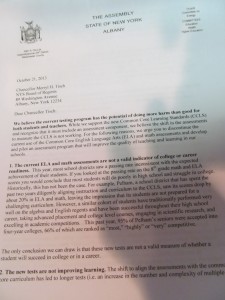Hits: 2297
WPCNR FOR THE RECORD. From Assemblyman David Buchwald (93rd Assembly District. October 24, 2013:
Three Assemblypersons after interviews with Superintendents and Assistant Superintendents of Schools recommended the Board of Regents of the State of New York suspend the 2014 Common Core Learning Standards Assessments this year, declaring the tests a failure, and not reflective of the real readiness of students to attend college. They also cited sharply increased costs due to more student Academic Intervention Services based on the 30 to 35% drop in test score passing rates, even in what were thought to be the area’s top school districts.
Here is a copy of that letter:
TheText:
October 21, 2013
Chancellor Merryl H. Tisch
NYS Board of Regents
89 Washington Avenue
Albany, New York 12234
Dear Chancellor Tisch:
We believe the current testing program has the potential of doing more harm than good for both students and teachers. While we support the new Common Core Learning Standards (CCLS) and recognize that it must include an assessment component, we believe the shift in the assessments to measure the CCLS is not working. For the following reasons, we urge you to discontinue the current use of the Common Core English Language Arts (ELA) and math assessments and develop and pilot an assessment program that will improve the quality of teaching and learning in our schools.
1. The current ELA and math assessments are not a valid indicator of college or career readiness. This year, most school districts saw a passing rate inconsistent with the expected achievement of their students. If you looked at the passing rate on the 8th grade math and ELA scores you would conclude that most students will do poorly in high school and struggle in college. Historically, this has not been the case. For example, Pelham, a school district that has spent the past two years diligently aligning instruction and curriculum to the CCLS, saw its scores drop by about 20% in ELA and math, leaving the impression that its students are not prepared for a challenging curriculum. However, a similar cohort of students have traditionally performed very well on the algebra and English regents and have been successful throughout their high school career, taking advanced placement and college level courses, engaging in scientific research, and excelling in academic competitions. This past year, 95% of Pelham’s seniors were accepted into four-year colleges, 66% of which are ranked as “most,” “highly” or “very” competitive.
The only conclusion we can draw is that these new tests are not a valid measure of whether a student will succeed in college or in a career.
2. The new tests are not improving learning.
The shift to align the assessments with the common core curriculum has led to longer tests (i.e. an increase in the number and complexity of multiple-choice questions on the ELA tests). Also, teachers have reported that many of the questions were too vague and did not align with the common core curriculum/content. Students who do not have the stamina to take longer tests or who get frustrated when faced with new material often just give up (which could be skewing the results). While students everywhere are exhibiting test anxiety, we are especially concerned about low performing students who get frustrated more easily. This could result in an antipathy toward learning. These recent test results have presented our schools with an additional significant challenge. Academic intervention services (AIS) were historically provided to any student in grades 3-8 who scored below proficiency on math or ELA. This year, districts reported that there just was not enough money in their budgets (nor was any forthcoming from the State) to cover the rise in the number of students eligible for AIS. Further, districts’ staffing needs were established during last year’s budget process. There is no way they could have anticipated the additional staffing needs required to support the many more students who now need AIS. Granting school districts greater leeway in determining which students should receive remedial help by setting a “threshold” score begs the questions: if the tests are a valid measure of student achievement then why do districts need to manipulate the scores and why are we denying low- scoring students the support services they truly need?
3. The new tests are not improving instruction.
Currently, teachers are not allowed to see the completed tests for each student; they receive only an aggregate score. Districts require more than just sampling or model questions to improve instruction. Individual test items must be provided so that meaningful programmatic adjustments can be made for each child and for the entire class. Also, as it stands now, teachers receive the test results well into the following school year denying them the opportunity to adjust lesson plans for the entering class. Teachers need to receive the results before the start of the school year. Just recently, we read that NYC schools had not received the new English and math text- books and other materials which match the tougher CCLS, presenting yet another reason to slow down the shift in assessments. There is a lot at stake – a child’s self esteem and a teacher’s reputation and perhaps career path are tied to these tests, putting a lot of pressure on both teachers and students to do well. We feel that teachers need this valuable time to teach critical thinking skills in an unpressured, stimulating environment.
4. The new tests are not a reliable measure of a teacher’s ability.
While the aggregate number of teachers falling into the State’s “effective” and “highly effective” categories has remained constant for two years, the rating system is less reliable when applied to an individual teacher. Too many teachers who were rated “highly effective” or “effective” last year were rated “ineffective” this year. Teachers do not change dramatically in one year. Receiving a low grade, especially after receiving a high grade in the prior year, is demoralizing and is not a reliable indicator of performance. Fortunately, most districts have adopted evaluation plans that minimize the impact of any one score. However, once the information is made public, a teacher is branded.
5. The cost of testing is creating financial hardship especially on school districts with fewer resources. Two districts, Locust Valley and Scarsdale, have estimated the cost of testing at between $2.5 and $2 million (includes the cost of data collection and lost teaching time), respectively. The cost may be higher for a larger district. While most school districts are struggling to stay within the tax cap, poorer districts have found it an even greater challenge and have already cut staff and programs, increased class size, and eliminated extra-curricula or enrichment programs. Running out of options, they will have to dig even deeper to meet their financial obligations to the detriment of the students.
The mandate to use computers for on-line testing by 2015 is another financial and educational dilemma for most school districts. Many districts, but especially the poorer ones, just do not have the technical capability nor the financial resources to implement this mandate by 2015. Also, all districts will be forced to give up instructional time by using the computer lab exclusively for testing. Schools and students have come to rely on computer labs for instruction, homework, and research assignments, all of which will be curtailed by this mandate.
We believe that State Education Department is moving too fast. We urge you to take the time to design an exemplary testing program that will be used as a model for improving teaching and learning for many years to come. Thank you for your consideration and for all that you do for the students of New York State.
Sincerely, Amy R. Paulin Thomas J. Abinanti David Buchwald Member of Assembly Member of Assembly Member of Assembly Cc: Vice Chancellor, Anthony Bottar Dr. James Dawson Dr. Geraldine Chapey Harry Phillips, 3rd James R. Tallon, Jr. Roger Tilles Charles R. Bendit Dr. Betty Rosa Dr. Lester W. Young, Jr. Dr. Christine D. Cea Wade S. Norwood
Dr. James O. Jackson Dr. Kathleen M. Cashin Dr. James E. Cottrell
T. Andrew Brown

